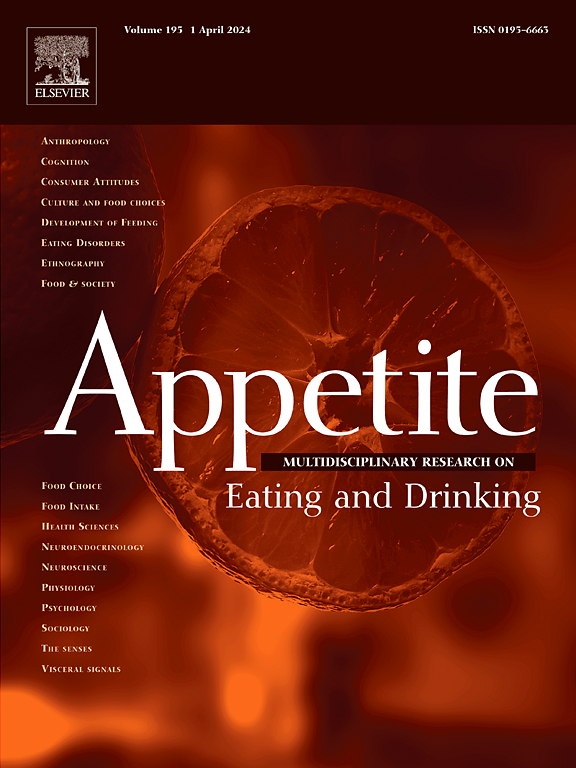开发婴儿吃饱后的行为(BABES)行为编码方案。
IF 4.6
2区 医学
Q1 BEHAVIORAL SCIENCES
引用次数: 0
摘要
目前的婴儿喂养建议提倡顺应性喂养,即护理人员根据婴儿的提示来决定喂养的速度和持续时间,以支持婴儿的自我调节和健康体重结果。顺应性喂养的核心原则是婴儿会有效地发出饥饿、接受喂食、需要停止喂食和饱食的信号,但目前缺乏支持这一假设的研究。相反,以往的研究表明,婴儿在喂养过程中表现出的行为暗示程度存在很大差异,而且许多母亲认为她们的婴儿没有清楚地表达饱腹感,这表明某些照顾者需要有针对性的支持,以了解婴儿在喂养互动过程中的需求。作为填补这一研究空白的第一步,我们开发了婴儿饱食时行为(BABES)编码方案,这是一种综合工具,用于评估婴儿在母婴喂养互动过程中的脱离/饱食行为以及母亲对婴儿行为和喂养方式的反应。BABES 适用于一项前瞻性纵向研究中的 876 个奶瓶喂养互动视频,该研究观察了婴儿 1、2、4、6、9 和 12 个月大时的二人组。编码者之间的可靠性达到了中等到较高的水平。描述性分析表明,婴儿和母亲在每个年龄段表现出不同行为的百分比与以往研究中指出的发育趋势一致。在未来的研究中应用该工具有可能创建丰富的数据集,从而描述婴儿和母亲行为的个体内和个体间差异,以及婴儿和母亲的行为如何在一岁内共同发展。本文章由计算机程序翻译,如有差异,请以英文原文为准。
Development of the Baby Behaviors when Satiated (BABES) behavioral coding scheme
Current infant feeding recommendations promote responsive feeding, wherein caregivers respond to infants' cues to determine feeding pace and duration, to support infant self-regulation and healthy weight outcomes. A central tenet of responsive feeding is that infants will effectively signal hunger, receptiveness to feeding, needs to disengage from feeding, and satiation, yet there is a lack of research available to support this assumption. Rather, previous research illustrates substantial variability exists for the extent to which infants exhibit behavioral cues during feeding and that many mothers feel their infants do not clearly communicate satiation, suggesting certain caregivers need tailored support to understand their infants' needs during feeding interactions. As a first step toward addressing this research gap, we developed the Baby Behaviors when Satiated (BABES) coding scheme, a comprehensive tool that assesses infants' disengagement/satiation behaviors and mothers' responses to infant behaviors and feeding practices during mother-infant feeding interactions. The BABES was applied to 876 videos of bottle-feeding interactions from a prospective, longitudinal study of dyads observed when infants were 1, 2, 4, 6, 9, and 12 months old. Coders achieved moderate to strong inter-rater reliability. Descriptive analyses illustrated that the percentages of infants and mothers exhibiting different behaviors at each age were consistent with developmental trends noted in previous research. Application of this tool within future research holds the potential to create rich datasets allowing for description of intra- and inter-individual variability in infant and mother behaviors and how infants' and mothers' behaviors co-develop across the first year.
求助全文
通过发布文献求助,成功后即可免费获取论文全文。
去求助
来源期刊

Appetite
医学-行为科学
CiteScore
9.10
自引率
11.10%
发文量
566
审稿时长
13.4 weeks
期刊介绍:
Appetite is an international research journal specializing in cultural, social, psychological, sensory and physiological influences on the selection and intake of foods and drinks. It covers normal and disordered eating and drinking and welcomes studies of both human and non-human animal behaviour toward food. Appetite publishes research reports, reviews and commentaries. Thematic special issues appear regularly. From time to time the journal carries abstracts from professional meetings. Submissions to Appetite are expected to be based primarily on observations directly related to the selection and intake of foods and drinks; papers that are primarily focused on topics such as nutrition or obesity will not be considered unless they specifically make a novel scientific contribution to the understanding of appetite in line with the journal's aims and scope.
 求助内容:
求助内容: 应助结果提醒方式:
应助结果提醒方式:


